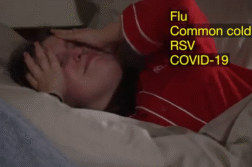ORLANDO, Fla. (Ivanhoe Newswire) — In the U.S., about one in five adults is currently providing unpaid health or supportive care to someone they love. It takes patience, time, and energy to be a caregiver and it isn’t always easy. Ivanhoe has some tips for any type of caregiver.
An aging parent, a sick spouse, or a child with a disability. Caregiving comes in different forms and it can be both rewarding and stressful. More than 65 million Americans provide care for a family member or friend during any given year. About 40 percent of caregivers leave their jobs to have more time to care for a loved one, and about half of all caregivers feel they have no choice about taking on the responsibilities. So, what makes for a good caregiver? The first step is to take care of yourself!
Rosemary Laird, MD, a geriatrician said, “A phrase I use often is ‘take your oxygen first.’ If you don’t, you’re going to be less capable of helping that loved one.”
Make sure you get plenty of rest, eat a well-balanced diet, and don’t skip your own medical appointments. Also, delegate responsibilities. For instance, if you’re providing day-to-day care, maybe another family member can manage finances or medications. When possible, let the person being cared for participate in decision-making. Support groups are another great resource to help you connect with other caregivers. And recognize when it becomes too much. You might want to consider an assisted living or other type of facility for your loved one.
“You can spend your time in a much more quality filled way than when you were having to dole out the medicine and fight with them to get a shower and do those tasks,” explained Dr. Laird.
A study found 18 percent of caregivers whose spouse had dementia died before their spouse. The Family Caregiver Alliance and Caregiver Action Network are good resources for finding online or in-person support groups.
Contributors to this news report include: Julie Marks, Producer; and Roque Correa, Editor.
HOW TO BE A GOOD CAREGIVER
REPORT #2826
BACKGROUND: According to a survey conducted for the National Alliance for Caregiving and the AARP Public Policy Institute, 40 million Americans provide care for an adult family member or friend. A caregiver is a person who tends to the needs or concerns of a person with short or long-term illness, injury or disability. Things that can define being a caregiver are helping a parent purchase and organize their medications, or taking a friend to their doctor’s appointments. Caregivers play a significant role in health care, as they are often the main source of valuable information about the patient.
CAREGIVER SELF-CARE: Over time, caregiver stress can lead to burnout, a condition marked by irritability, fatigue, problems with sleep, weight gain, feelings of helplessness or hopelessness, and social isolation. Caregiver burnout is an example of how repeated exposure to stress harms mental and physical health. There are ways to cope with caregiver burnout like being kind to yourself. Self-compassion means giving yourself credit for the tough, complex work of caregiving, stepping away from the self-critical, harsh inner voice, and allowing yourself time. Mind-body practices can build physical health and deepen the awareness and connection between the mind and body. Yoga has been shown to reduce stress in caregiving groups. Maintaining adequate sleep and nutrition are key to preventing caregiver burnout. Build a daily 10-minute nighttime routine to achieve more restful sleep. And, nutrition can also be an important factor to prevent burnout. Avoid or reduce alcohol, since alcohol both increases inflammation in the body and disrupts quality of sleep.
(Source: https://www.health.harvard.edu/blog/self-care-for-the-caregiver-2018101715003)
THE FUTURE OF CAREGIVING: Ai-Jen Poo, leader of Caring Across Generations, states “for generations, our default caregiving infrastructure was essentially women staying home.” This seems to be the same feeling around caregiving, that it’s not a real profession because it’s the responsibility of someone else. But in the modern era of full-time employment, shift work and rising costs of living, we are less and less able to care for our loved ones as they get older. Ai-Jen believes that radical change is needed to achieve this, with “access to the support structures and systems that allow for us to take care of our families while we work” being the ultimate goal. A large part of this goal will be the role that adult day care and home care plays in helping elderly and less actively mobile people get the care they need. And also, a change in the perception of caregiving as a profession is needed so it can become a career option that is no longer seen as a stop gap.
(Source: https://caregiversamerica.com/future-caregiving-invisible-profession/)
* For More Information, Contact:
Holly Cammisa
CFDExternalComm@adventhealth.com.
Free weekly e-mail on Medical Breakthroughs from Ivanhoe. To sign up: http://www.ivanhoe.com/ftk



